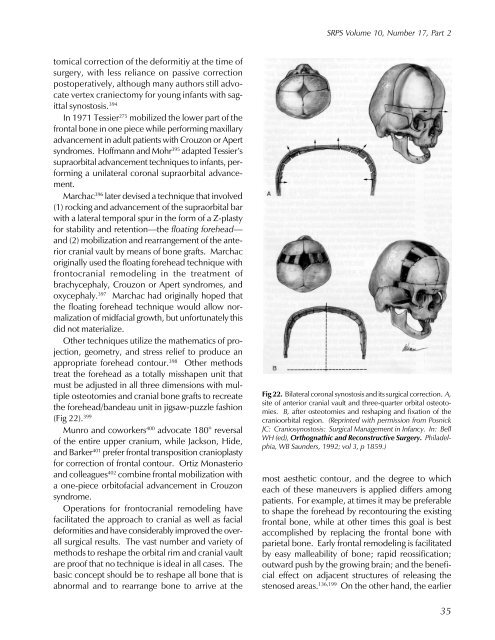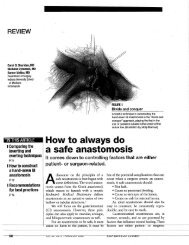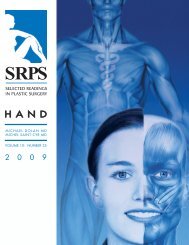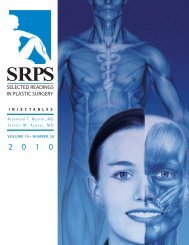Craniofacial Anomalies, Part 2 - Plastic Surgery Internal
Craniofacial Anomalies, Part 2 - Plastic Surgery Internal
Craniofacial Anomalies, Part 2 - Plastic Surgery Internal
You also want an ePaper? Increase the reach of your titles
YUMPU automatically turns print PDFs into web optimized ePapers that Google loves.
tomical correction of the deformitiy at the time of<br />
surgery, with less reliance on passive correction<br />
postoperatively, although many authors still advocate<br />
vertex craniectomy for young infants with sagittal<br />
synostosis. 394<br />
In 1971 Tessier 275 mobilized the lower part of the<br />
frontal bone in one piece while performing maxillary<br />
advancement in adult patients with Crouzon or Apert<br />
syndromes. Hoffmann and Mohr 395 adapted Tessier’s<br />
supraorbital advancement techniques to infants, performing<br />
a unilateral coronal supraorbital advancement.<br />
Marchac 396 later devised a technique that involved<br />
(1) rocking and advancement of the supraorbital bar<br />
with a lateral temporal spur in the form of a Z-plasty<br />
for stability and retention—the floating forehead—<br />
and (2) mobilization and rearrangement of the anterior<br />
cranial vault by means of bone grafts. Marchac<br />
originally used the floating forehead technique with<br />
frontocranial remodeling in the treatment of<br />
brachycephaly, Crouzon or Apert syndromes, and<br />
oxycephaly. 397 Marchac had originally hoped that<br />
the floating forehead technique would allow normalization<br />
of midfacial growth, but unfortunately this<br />
did not materialize.<br />
Other techniques utilize the mathematics of projection,<br />
geometry, and stress relief to produce an<br />
appropriate forehead contour. 398 Other methods<br />
treat the forehead as a totally misshapen unit that<br />
must be adjusted in all three dimensions with multiple<br />
osteotomies and cranial bone grafts to recreate<br />
the forehead/bandeau unit in jigsaw-puzzle fashion<br />
(Fig 22). 399<br />
Munro and coworkers 400 advocate 180° reversal<br />
of the entire upper cranium, while Jackson, Hide,<br />
and Barker 401 prefer frontal transposition cranioplasty<br />
for correction of frontal contour. Ortiz Monasterio<br />
and colleagues 402 combine frontal mobilization with<br />
a one-piece orbitofacial advancement in Crouzon<br />
syndrome.<br />
Operations for frontocranial remodeling have<br />
facilitated the approach to cranial as well as facial<br />
deformities and have considerably improved the overall<br />
surgical results. The vast number and variety of<br />
methods to reshape the orbital rim and cranial vault<br />
are proof that no technique is ideal in all cases. The<br />
basic concept should be to reshape all bone that is<br />
abnormal and to rearrange bone to arrive at the<br />
SRPS Volume 10, Number 17, <strong>Part</strong> 2<br />
Fig 22. Bilateral coronal synostosis and its surgical correction. A,<br />
site of anterior cranial vault and three-quarter orbital osteotomies.<br />
B, after osteotomies and reshaping and fixation of the<br />
cranioorbital region. (Reprinted with permission from Posnick<br />
JC: Craniosynostosis: Surgical Management in Infancy. In: Bell<br />
WH (ed), Orthognathic and Reconstructive <strong>Surgery</strong>. Philadelphia,<br />
WB Saunders, 1992; vol 3, p 1859.)<br />
most aesthetic contour, and the degree to which<br />
each of these maneuvers is applied differs among<br />
patients. For example, at times it may be preferable<br />
to shape the forehead by recontouring the existing<br />
frontal bone, while at other times this goal is best<br />
accomplished by replacing the frontal bone with<br />
parietal bone. Early frontal remodeling is facilitated<br />
by easy malleability of bone; rapid reossification;<br />
outward push by the growing brain; and the beneficial<br />
effect on adjacent structures of releasing the<br />
stenosed areas. 136,199 On the other hand, the earlier<br />
35






